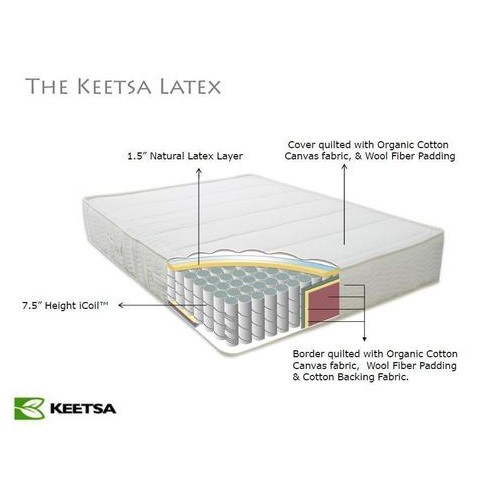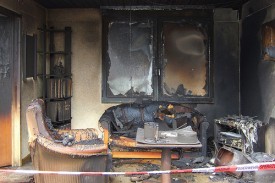Eureka! The California legislature will this spring consider a bill to modernize the 12-second rule, the state’s obscure furniture flammability standard that fails to protect us from fires even while it poisons homes across North America. Over the past seven months, we’ve described this scientifically discredited standard; provided nine (adorable) reasons to modernize the standard; refuted Big Chem’s star witness; and uncovered the engine of toxic political influence that shuns fire safety in favor of profits.
This time, we bring hopeful tidings.
Late last month, Rep. Holly Mitchell (D-Los Angeles) introduced AB 2197, a bill that will bring California’s flammability standard into line with 35 years of independent fire safety science and 20 years of research by the US government.
AB 2197, backed by a coalition of firefighters, scientists, businesses, consumers, and public health advocates, is simple, effective, and constructive. It’s worth a read.
The bill replaces the 12-second rule, which relies on an open flame ignition standard—furniture foam cannot ignite when exposed to an open flame for 12 seconds. Because this test applies only to furniture foam and not to the cover fabric that first encounters flames in real fires, it provides no fire safety benefits. All it does is put pounds of toxic chemicals into our homes.
The modernized standard is based on smolder ignition. In the test, a lit cigarette is placed on a model piece of furniture called a “mock-up” for 45 minutes. If the smoldering cigarette turns into flames at any point, the mock-up fails the test. After 45 minutes, the fabric cannot continue to smolder and the foam underneath cannot have lost more than 10 percent of its mass.
The US Consumer Product Safety Commission devised the smolder ignition standard. CPSC staff reviewed national fire loss estimates for 2002-2004 and found, “approximately 90% of estimated deaths, 65% of estimated injuries, and 59% of property damage resulted from ignition by smoking materials, almost always cigarettes.” Whereas the 12-second rule is 0 percent effective, the modernized standard would likely be 60 percent effective at reducing these deaths, injuries, and damages. And it does not have the side effect of promoting use of toxic chemicals.
Furniture manufacturers can use either of two strategies to comply with the CPSC’s smolder ignition standard. They can use smolder-resistant cover materials such as wool, which is naturally fire-resistant, or they can use natural barriers between the cover fabric and the interior foam.
Natural fabrics, natural barriers, no toxic chemicals! Too good to be true? CPSC implemented a similar flammability standard for mattresses in 2007, and it is commonly met using inexpensive barrier technology rather than by blending increasingly expensive flame retardants into foam. The figure below illustrates how one mattress manufacturer wraps its mattresses with a layer of wool quilting to comply with the flammability standard. In the intervening 5 years, one CPSC model estimates this tough flammability standard has resulted in at least 1,200 fewer deaths and 5,750 fewer injuries from mattress fires. Countless more people were spared exposure to toxic chemicals.

AB 2197 is the sixth attempt in six years to curtail toxic flame retardants in furniture. A bill introduced in 2007 banned a particularly dangerous flame retardant, but it failed. In 2008, a bill outlawed a host of dangerous flame retardants. It failed. In 2009, a bill sought exemption for children’s products. It failed. A bill in 2010 placed flame retardants under regulatory control of California’s Green Chemistry Initiative. It failed. Last year, Sen. Mark Leno (D-San Francisco) introduced a mild bill that offered manufacturers an alternative flammability standard. It failed in committee.

This year, champions for change are upping the ante. Instead of a piecemeal approach, they are demanding a tough flammability standard that actually protects Californians from fire—and from chemicals. It’s not just Californians seeking protection. California’s legislative dogfight is of global significance. Natural Resources Defense Council’s Sarah Janssen points out, “The entire world is watching California to see if we will act to prevent continuing global contamination from chemicals used to meet [the 12-second rule].”
AB 2197 will have to fend off Big Chem, its proxies, and its misled parade of witnesses. Ana Mascareñas of Physicians for Social Responsibility notes, “The chemical industry has targeted individuals from the medical profession, communities of color, and firefighter communities, misrepresenting the science. Just this past week, a UC Davis study was the newest among many that link fire retardant chemical exposure to autism spectrum disorders, learning disabilities, decreased fertility, and other serious health conditions.”
Rachel Sarnoff from Healthy Child, Healthy World echoes, “Moms and dads shouldn’t feel they have to be biochemists to shop for safe products for their children.”
The 12-second rule is poisoning people without any fire safety benefit. AB 2197 is an opportunity to modernize the obsolete standard and protect people from both fire and poisonous chemicals.
You can help in two ways. First, make your voice heard by calling or writing to the California Assembly Committee on Environmental Safety and Toxic Materials:
- 916.319.3965 (phone)
- 916.319.3950 (fax)
- 1020 N Street, Room 171, Sacramento, California 95814 (snail mail)
Make sure legislators know that Cascadians are invested in modernizing California’s flammability standard, and that you don’t want to buy furniture made for sale in California if the current standard persists.
Second, help me with my next article: I am looking for Californians who have suffered from furniture fires. Do you know burn survivors willing to share their stories and illustrate the costs of perpetuating a weak, scientifically-discredited flammability standard? Let me know at editor@sightline.org.
Mattress diagram courtesy of ErgoComfort, a company that sells the Keetsa Latex Mattress with natural barrier technology.
Valerie Pacino is a Sightline Intern, a Master of Public Health student, and a hopeful couch potato.
Read more about toxic couches:
- Pt. 1: An Obscure California Regulation Fills Homes with Toxics
- Pt. 2: Puppies, Kittens, and Toxic Couches
- Pt. 3: Putting the Chemical Witness on the Hot Seat
- Pt. 4: Toxic Money
- Pt. 5: Have Toxic Couches Finally Met Their Match?
- Pt. 6: Toxic Couches: the Infographic


Comments are closed.